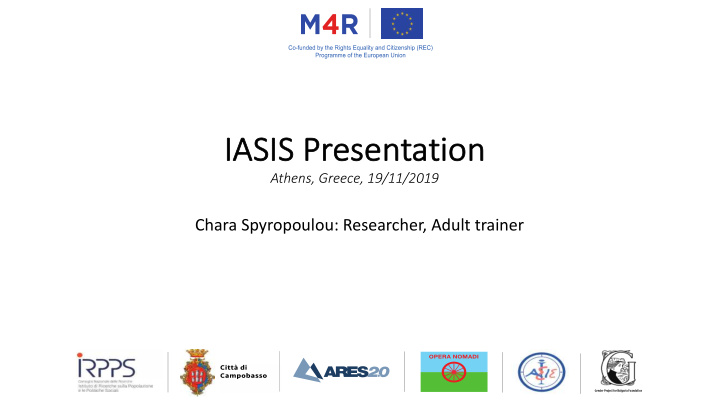



IA IASIS IS Presentation ion Athens, Greece, 19/11/2019 Chara Spyropoulou: Researcher, Adult trainer
Roma people in Greece Integral part of the Greek population -self identification-not with a minority status. • Recognised by the State as one of the socially vulnerable groups lacking basic goods and services for whom the State has adopted and implements mainstreaming and targeted policies of holistic character in all spheres of social GENERAL INFORMATION: Historical information: • Greece was one of the first countries that accepted Roma in their migration journey in Europe.* It is calculated that ROMA installed in Greece at about 13th and 14th century.* • Until 1860 they were slaves.* • • At WWII the ROMA executed with other marginalized groups.* • In Greece there are two teams of Roma: These who are transporting all the time because they are street traders and they need to move constantly. The other category include the Roma who are located in isolated areas on the fringes of the towns or in small villages.* *References: https://en.wikipedia.org/wiki/Romani_people_in_Greece
Current Situation Source: FRA, EU-MIDIS II Survey , 2016 HOUSING - Lack of basic infrastructure - Substandard housing - Environmental pollution due to the absence of a rainwater network - not connected to utility networks - Hygiene conditions in certain Roma settlements that threaten public health EDUCATION -High illiteracy rate and limited participation in the education system. -96% of Roma aged 18 to 24 years are early leavers from education or training, -58% never been in formal education/not completed primary education (ISCED 0), -33% has completed primary education (ISCED 1), -6% lower secondary education (ISCED 2), -2% upper secondary, vocational, post secondary, short cycle education (ISCED3 to 5).
Current Situation Source: FRA, EU-MIDIS II Survey , 2016 EMPLOYMENT 26% of Roma people are unemployed, 23% work full-time mostly self - employed, 20% part-time/occasional work, 1% • are students or in training, 25% domestic tasks and care responsibilities, 2% are retired and 3% are not working due to illness or disability In paid work 52% (Main current activity is work or have worked in the last 4 weeks earning some money (only working • age population, 20-64 years) Notable gender differences for those in paid work : 82% are male and 22% female • High percentage of undeclared work • HEALTH 83% of Roma people stated that their health is “good” or “very good”, while 10% replied that their health is “fair” and • 7% as “bad or very bad”. 14% stated longstanding illness or health problem. • Roma people have access to public healthcare system as all Greek citizens. However, substandard conditions have a • rather negative impact on health. Disability • Low life expectancy • Limited information on prevention •
Ma Mappi pping ng and nd cl classification TYPES No of SETTLEMETS POPULATION 76 8.582 Type 1: “Most degraded areas- Unacceptable living conditions in huts, shelters lacking basic infrastructures Type 2: Mixed camps- houses together with 159 59.292 short – term facilities (shelters, tents, containers often used on a permanent basis and partial infrastructure (Water supply, electricity, roads), usually in the vicinity of a built –up area 119 36.336 Type 3: Neighborhood in permanent use, often in distressed / disadvantaged areas of the urban fabric (mainly houses, usual buildings- apartment flats or detaches houses and some containers) TOTAL 354 104.210
Na Nation onal Strategy for or Rom oma Soc ocial Inclusion on 2012-2020 2020 Specialization of the national strategy in an operational plan Policies and actions grouped around 5 pillars HOUSING EMPLOYMENT EDUCATION SOCIAL INCLUSION (Focus on HEALTH empowerment)
National Strategy for Roma Social Inclusion 2012-2020 HOUSING EDUCATION EMPLOYMENT HEALTH SOCIAL INCLUSION (supporting -Temporary -Mainstreaming -Interventions -Hygienic Reports measures) Relocation policies promoting Roma -Personal Hygiene -Roma Branches -Rent Subsidy (school snacks, Employment & Infrastructure (public -cultural events - Infrastructure Reception classes Entrepreneurship baths and areas for Planning process: -utility networks etc.) the cleaning of -summer camps -Targeted policies for -Promoting social clothing ) -workshops for Roma economy -Environmental children & parents (assistance for school (mainstream) infrastructure work and school attendance, etc.) -legislative measures Direct actions in 47 for itinerant trade primary schools (Social workers at schools) Schools)
Work orksh shop op The workshop will be implemented as following: -4 to 5 groups will have flipcharts and markers and will create 5 presentations regarding the similarities and the differences existed related to the Greek Strategy for ROMA Social Inclusion (slide 7). Then they will present their results among the participants and they will add some information regrading their National contexts. They can use Internet resources for the collection of the information needed for the application of this activity. -The aim of this activity is to exchange the strategies among European countries and to aware about the existed good practices related to social inclusion of ROMA people. -Materials needed: flipcharts or A3 papers, markers, internet connection
More recommend